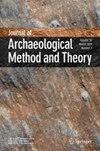跨越时间的对话?概念化El Castillo (Cantabria, Spain)旧石器时代晚期洞穴艺术中回写的时间关系。
IF 2.8
1区 历史学
Q1 ANTHROPOLOGY
引用次数: 0
摘要
在旧石器时代晚期,洞穴遗址经常被重复使用,欧洲西南部的许多遗址都有很深的活动年表。与相同洞穴或洞穴内空间的重复接触,在这些遗址的洞穴艺术描绘的重叠中是显而易见的。虽然这些旧石器时代晚期洞穴艺术的回写已经被广泛研究,以了解特定地区或遗址内艺术的相对年代学,但它们还没有从本体论的角度得到理解。旧石器时代晚期艺术家对其前辈创作的主题的参与,无论其文化连续性如何,可能表明在文化和时间上不同的狩猎采集者群体之间发生了对话互动。在本文中,我们提出了一个概念框架-灵感来自关系和当代岩石艺术生产-来理解这些时间的相互作用。关注El Castillo的案例研究,我们认为这些跨越时间的接触可能暂时表明旧石器时代晚期狩猎采集者本体的长期连续性,反映在洞穴艺术的回写中。补充信息在线版本包含补充资料,可在10.1007/s10816-025-09717-5获得。本文章由计算机程序翻译,如有差异,请以英文原文为准。
Dialogues Across Time? Conceptualising the Temporal Relationships of Palimpsests in the Upper Palaeolithic Cave Art of El Castillo (Cantabria, Spain).
Cave sites were frequently reused throughout the Upper Palaeolithic, with many sites within south-western Europe having deep chronologies of activity. The repeated engagement with the same caves, or spaces within caves, is evident in superimpositions of cave art depictions within these sites. Whilst these palimpsests in Upper Palaeolithic cave art have been extensively studied with regard to understanding the relative chronology of art within a particular region or site, they have not been understood from an ontological perspective. Upper Palaeolithic artist's engagement with motifs produced by their predecessors, regardless of cultural continuity, may indicate dialogical interactions occurring across time between culturally and temporally distinct groups of hunter-gatherers. In this paper, we propose a conceptual framework-inspired by relationality and contemporary rock art production-for understanding these temporal interactions. Focusing on the case study of El Castillo, we argue that these engagements across time may tentatively indicate aspects of long-term continuity in the ontology of Upper Palaeolithic hunter-gatherers, reflected in cave art palimpsests.
Supplementary Information
The online version contains supplementary material available at 10.1007/s10816-025-09717-5.
求助全文
通过发布文献求助,成功后即可免费获取论文全文。
去求助
来源期刊
CiteScore
6.30
自引率
8.70%
发文量
43
期刊介绍:
The Journal of Archaeological Method and Theory, the leading journal in its field, presents original articles that address method- or theory-focused issues of current archaeological interest and represent significant explorations on the cutting edge of the discipline. The journal also welcomes topical syntheses that critically assess and integrate research on a specific subject in archaeological method or theory, as well as examinations of the history of archaeology. Written by experts, the articles benefit an international audience of archaeologists, students of archaeology, and practitioners of closely related disciplines. Specific topics covered in recent issues include: the use of nitche construction theory in archaeology, new developments in the use of soil chemistry in archaeological interpretation, and a model for the prehistoric development of clothing. The Journal''s distinguished Editorial Board includes archaeologists with worldwide archaeological knowledge (the Americas, Asia and the Pacific, Europe, and Africa), and expertise in a wide range of methodological and theoretical issues. Rated ''A'' in the European Reference Index for the Humanities (ERIH) Journal of Archaeological Method and Theory is rated ''A'' in the ERIH, a new reference index that aims to help evenly access the scientific quality of Humanities research output. For more information visit: http://www.esf.org/research-areas/humanities/activities/research-infrastructures.html Rated ''A'' in the Australian Research Council Humanities and Creative Arts Journal List. For more information, visit: http://www.arc.gov.au/era/journal_list_dev.htm

 求助内容:
求助内容: 应助结果提醒方式:
应助结果提醒方式:


